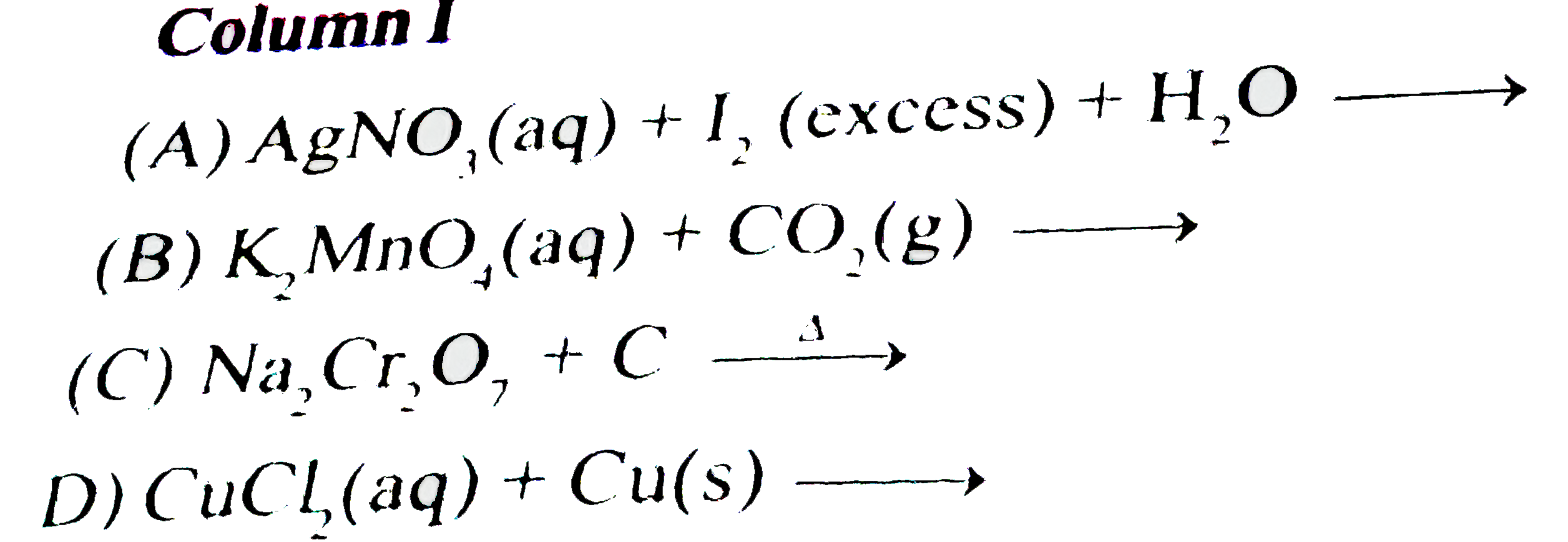Complete Solutions to Miscellaneous Solved Problems of chapter D & F-BLOCK ELEMENTS & THEIR IMPORTANT COMPOUNDS of Class 11 book with complete answers and questions
| Class 11 | CHEMISTRY |
| Chapter | D & F-BLOCK ELEMENTS & THEIR IMPORTANT COMPOUNDS |
| RESONANCE NEW | Miscellaneous Solved Problems |
| Number Of Questions | 16 |
| Academic Year | 2023-24 |
Among the following statement choose the true or false statements(s).
A) `K_(2)Cr_(2)O_(7)` on heating with charcoal gives metallic potassium and `Cr_(2)O_(3)`
B) On heating in current of `H_(2)` the crystalline `KMnO_(4)` is converted into `KOH` and `Mn_(3)O_(4)`
C) Hydrated ferric chloride on treatment with `2-2`-dimethoxypropane gives anhydrous ferric chloride.
View SolutionA compound `(A)` is used in paints instead of salts of lead.Compound(A) is obtained when a white compound `(B)` is strongly heated . Compound `(B)` is insoluble in water but dissolves in sodium hydroxide forming a solution of compound `(C )` the compounds `(A)` on heating with coke gives a metal `(D)` and a gas `(E)` which burns with blue flame . `(B)` also dissolves in ammonium sulphate solution mixed with ammonium hydroxide. solution of compound `(A)` in dilute `HCl` gives a bluish white//white precipitate `(F)` with excess of `(F)` with excees of `K_(4)[Fe(CN)_(6)]` identify `(A)` to `(F)` and explain the reactions.
View SolutionAn unknown inorganic compound `(X)` gave the following reactions:
(i) The compound `(X)` on heating gave a residue, oxygen and oxide of nitrogen.
An aqueous solution of compound `(X)` on addition to tap water gave a turbidity which did not dissolve in `H_(3)O^+`
(iii) The turbidity dissolved in `NH_(4)OH` .
Identify the compound `(X)` and gives equation for the reaction (i),(ii) & (iii)`
View SolutionAmongst `TiF_6^(2-), CoF_6^(3-), Cu_2Cl_2" and " NiCl_4^(2-)`, which are the colourless species ? (atomic number of Ti = 22 , Co = 27, Cu = 29, Ni = 28)
View SolutionOn the basis of trends in the properties of the `3d`-series elements , suggested possible `M^(2+)` aqua ions for use as reducing agents , and write a balanced chemical equation for the reaction of one of those ions with `O_(2)` in acidic solution.
View Solution`CrO_3` is an acid anhydride of
View SolutionWhich of the following is true for the speical having `3d^(4)` configuration ?
View SolutionWhich of the following increasing order of oxidising power is correct for the following species?
`VO_(2)^(+),MnO_(4)^(-),Cr_(2)O_(7)^(2-)`
View SolutionWhich of the following statements is/are correct?
View SolutionWhen `CO_(2)` is passed into aqueous:
View SolutionWhich of the following statements (s) is (are) correct with reference to the ferrous and ferric ions?
(a). `Fe^(2+)` gives brown colour with potassium ferricyanide.
(b). `Fe^(2+)` gives blue precipitate with potassium ferricyanide.
(c). `Fe^(3+)` gives red colour with potassium thiocyanate.
(d). `Fe^(3+)` gives brown colour with potassium thiocyanate.
View SolutionAssertion : Ammoniacal silver nitrate converts glucose to gluconic acid and metallic silver is precipitated.
Reason : Glucose acts as a week reducing agent.
View SolutionStatement: The number of unpaired electrons in the following gaseous ion:
`Mn^(3+),Cr^(3+),V^(3+) and Ti^(3+)` are `4,3,2` and 1 respectively
Statement: `Cr^(3+)`is most stable in aqeous solution among these ions.
View Solution`S_(1)`interstitial compound have high melting points, higher than those of pure metals.
`S_(2)` Permanganate titration in presence of hydrochloric acid are unsatisfactory
`S_(3)`: `KmnO_(4)` does not act as an oxidising agent in strong alkaline medium.
`S_(4):KMnO_(4)` On heating in a current of `H_(2)` gives `MnO`
View SolutionMatch the reactions in Column I with nature of the reactions `//` type of the products in Column II.


View SolutionWhat is the composition of mischmetal alloy and what are it's uses?
View Solution
Miscellaneous Solved Problems questions and complete solutions for chapter D & F-BLOCK ELEMENTS & THEIR IMPORTANT COMPOUNDS of RESONANCE ENGLISH of Class 11
All Exercises from RESONANCE NEW Class 11 CHEMISTRY D & F-BLOCK ELEMENTS & THEIR IMPORTANT COMPOUNDS
- Additional Problems for Self practice (APSP)
- Exercise 1
- Exercise 2
- Exercise 3
- High Level Problems
- Match the column
- Miscellaneous Solved Problems
- National Standard Examination In chemistry
- One Integer Value Correct Type.
- One or more than one options correct type
- Only one option correct type
- Paragraph
- Single And Double Value Integer Type
- Subjective Questions